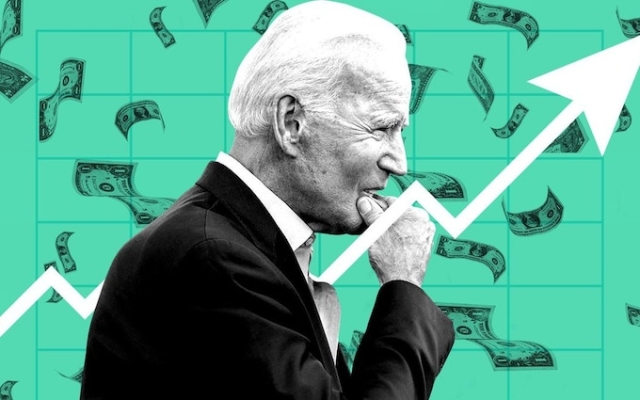 There is a risk that the US government could default on its debt. Photo: The Telegraph
There is a risk that the US government could default on its debt. Photo: The Telegraph
U.S. President Joe Biden and Speaker Kevin McCarthy agreed on a deal on a debt limit to lift the ceiling and prevent a catastrophic default.
An act to temporarily suspend the US borrowing ceiling and cap federal spending has been introduced by the House Rules Committee and will be submitted to a vote in the House of Representatives today.
Congress is rushing to pass this measure before June 5, the date when Treasury Secretary Janet Yellen has warned that the US is at risk of default, which could trigger a global economic downturn.
U.S. lawmakers have been arguing for weeks over whether to raise or suspend the so-called «debt ceiling,» which determines how much money the government can borrow USA.
Despite breaking the deadlock between Republicans and Democrats, the White House and Mr. McCarthy must now overcome bipartisan opposition threatening to block the bill.
What went wrong and what's included in the debt ceiling deal?< /p> What is the US debt ceiling?
Since 1917, the US has had a law that sets a statutory limit on the total amount of debt that the government is allowed to have. Initially, the limit was set at $11.5 billion (£9.2 billion).
The ceiling is a bit like the fiscal rules that the Chancellor himself sets in the UK, but it is set from outside. “The key issue is that this is seen as completely separate from decisions about how much the government should spend and what level of taxes should be,” says Hunter.
Congress passes new spending bills that will increase debt. , but the debt ceiling does not rise until it is exceeded.
This figure has also been set as a general monetary figure that does not automatically change, reflecting factors such as population growth or inflation, acting as a sort of gastric band.
America's national debt has increased under each individual president. since Herbert Hoover. In response, the debt ceiling was raised more than 100 times. Now it is 31.4 trillion dollars.
The US national debt hit that level in January, meaning the government cannot legally borrow more money.
The debt ceiling could be raised again, but only if the House of Representatives votes on it, in which the majority are Republicans. When the ruling party does not have a majority in the House of Representatives — as is the case with the current administration — there is no guarantee that an agreement will be reached.
Past battles for the debt ceiling usually ended in a hasty agreement reached in the last hours of negotiations, thus avoiding default.
In 2011, the struggle led to a downgrade of the country's top credit rating. Veterans of that battle warn that the current situation is even more risky as political divisions widen.
What's included in the debt ceiling deal?
President Biden called the deal «an important step forward» and «good news for the American people because that it prevents what could be a catastrophic default and lead to an economic downturn, emptying retirement accounts and losing millions of jobs.”
He noted, however, that the agreement was a necessary compromise. “Not everyone gets what they want,” Biden said. «This is the responsibility of leadership.»
The agreement suspends the country's $31.4 trillion debt ceiling for two years until the next US presidential election in 2024.
This allows the Treasury to keep borrowing money to pay bills on time, securing the deal. approved by the House and Senate before the default deadline next week.
It differs from a previous bill passed by Republicans in the House of Representatives, which agreed to raise the debt limit by $1.5 trillion, but only on the condition that that spending would be cut to 2022 levels and then capped at 1% a year.
In exchange for lifting the borrowing cap, the Republicans demanded a series of political concessions over the next two years. Agreement…
- Reduces non-defense discretionary spending such as domestic law enforcement, forest management, and scientific research. Discretionary spending in fiscal 2024 will remain flat and growth in 2025 will be capped at 1 percent below inflation.
- Recovers about $30 billion of unspent money from federal programs offering financial support during the pandemic .
- Cancels about $1.4 billion of funding provided by Democrats to support the Internal Revenue Service in the fight against tax evasion, and allocates another $20 billion. repurposed over the next two years
- Repeals the moratorium on student loan repayments that the Biden administration put in place to ease the situation for borrowers during Covid
- By 2025, new work requirements for adults in aged 50 to 54 who receive food stamps.
According to the non-partisan Congressional Budget Office, these spending cuts will reduce the debt deficit by $1.5 trillion over a decade.< /p>
However, a handful of far-right Republicans said they would oppose the deal because the spending cuts weren't far enough away.< /p>
The bipartisan deal passed its first legislative hurdle on Tuesday after the powerful House Rules Committee voted seven to six to move the bill forward. The fate of the agreement will be decided by a decisive House-wide vote on Wednesday.
US Debt Ceiling Chart 0405 US Government Net Debt What happens if the debt ceiling cannot be raised or suspended?
The US government runs a deficit, which means it spends more money than he collects in taxes.
This means two things. First, every year the amount of his debt increases, and hence the cost of servicing it. Second, if it can no longer borrow money, the government will stop covering all of its expenses.
The US Treasury Department's cash balance at the end of April was $316 billion. “The question is, when will this money run out?” says Hunter. Treasury Secretary Janet Yellen says it will happen in June.
When that money runs out, the government can only spend the money it receives in taxes. Therefore, it will no longer be able to meet all of its public spending obligations, such as paying public sector wages, or service all of its existing debt.
Treasury bonds maturing in June may not be redeemed. According to Hunter, this could trigger a financial crisis.
What happens if the US government defaults on its debt?
Theoretically, if America defaults on its debt, this will cause shocks in the value of its public debt. .
The majority (69%) of US debt is owed to America. The Federal Reserve owns 21.2%, 12% is owned by pension funds or mutual funds, and 6.7% is owned by US households.
Another 31 percent is owned by foreigners. Japan is the largest holder of US Treasury securities, worth about $1.1 trillion. China and the UK hold $867bn and $654bn respectively.
But if America defaults, the consequences could be much more severe.
“US government debt is considered the safest asset. in the financial system, and it is also a lot. As a result, a very significant part of the price of any other financial asset is somehow dependent on the price of US government debt,” says Hunter. , in turn, will cause a corresponding increase in the cost of borrowing around the world.
“Essentially, all of a sudden, every safe asset will suddenly look a lot less safe than before. If this is suddenly threatened with default, then virtually all bets in terms of what happens in the broader financial markets will be taken off,” he adds.
“Failure to reach an agreement at all will lead to more severe macroeconomic shocks, given the current scale of the federal budget deficit and the actions needed to close it quickly,” warned the Organization for Economic Co-operation and Development.
Man has created a problem
However, the question remains how investors will react to a default due to the debt ceiling, because the problem will be completely artificial.
“The big difference between a potential default as a result of a debt ceiling and, say, a default in a country like Argentina that has defaulted numerous times throughout history is that this is possibly the only time a country has ever defaulted. on their obligations. debt is largely by choice, not economic necessity,” says Hunter.
There is no suggestion that America cannot afford to continue paying its debts, but the government will be bound by law. “It created a kind of artificial default risk,” says Hunter.
In the past, America has been even closer to the deadline. Back in 2011, the agreement was reached on the day the government was supposed to run out of money. In 2013, there was another sharp decline.
Previously, when the government nearly ran out of money, although interest rates on expiring Treasury bills jumped, yields on 10-year Treasury bonds actually fell sharply. «Even when the deadline was so close, people still didn't think there was a realistic possibility that the US government would suddenly stop paying all of its debt,» says Hunter.
The problem was more of a short-term failure. Long-term yields have declined, likely due to expectations that interest rates will stay low longer due to economic weakness and uncertainty, Hunter said.
But this time the stakes are higher. Back in 2011, the federal debt was 65.8% of US GDP. Now it's 98 pcs. Interest rates are also much higher. Both of these factors together mean that the government is facing much higher debt servicing costs. “In terms of the sustainability of the US public finances, this situation is even worse than it was 10 years ago,” says Hunter.
When is the deadline for resolving the crisis?
The deadlines are getting tighter. Back in January, when Yellen wrote to McCarthy warning that the debt ceiling was about to be reached, she said it was unlikely the cash would run out before early June.
But in early May, Yellen said the date could be as early as June 1st. At this point, she noted that the actual date «could be a few weeks later than these estimates.»
Last week, Yellen extended the default deadline to June. 5. She said: «Based on the most recent data available, we now estimate that the Treasury will not have enough resources to meet the government's obligations unless Congress raises or suspends the debt limit by June 5.»
Timing became so compressed that President Joe Biden was forced to cancel a trip to the Indo-Pacific region for a summit involving Australia, India and Japan, as well as a visit to Papua New Guinea.


















































Свежие комментарии